The ashes have settled over the charred Louisville neighborhood where nine people remain missing and families cling to hope as investigators comb through the wreckage of Tuesday’s fatal UPS cargo plane crash.
A McDonnell Douglas MD-11 aircraft plummeted from the sky in Kentucky into a community on the edge of the airport, killing at least 14 people, and carving a trail of fire that consumed businesses and forced panicked victims to jump from the windows to escape the inferno.
For now, UPS and FedEx have immediately grounded their entire fleet of MD-11 aircrafts as investigators from the National Transportation Safety Board gather every fragment of evidence to piece together what happened in those final seconds before impact.
It’s been a year marked by aviation tragedies – and this crash raises the same haunting question: What went wrong this time? Here’s what we know so far.
Shortly after taking off from Louisville Muhammad Ali International Airport, the cargo plane’s engine and the pylon, which supports the engine, fell off the left wing of UPS flight 2976 as it accelerated for takeoff, the NTSB said.
Investigators have yet to determine why it happened, but operators are erring on the side of caution until answers emerge.
“Out of an abundance of caution and in the interest of safety, we have made the decision to temporarily ground our MD-11,” UPS said in a statement. “Nothing is more important to us than the safety of our employees and the communities we serve.”
McDonnell Douglas MD-11 aircrafts are used exclusively for cargo operations and make up about 9% of the UPS fleet. The company said it had contingency plans to temporarily operate without them.
FedEx, the only other major US airline to operate the MD-11, will also ground them for “a thorough safety review based on the recommendation of the manufacturer,” a spokesperson said in a statement.
The decisions come after recommendations from Boeing, which merged with McDonnell Douglas in 1997.
The Federal Aviation Administration is aware UPS and FedEx voluntarily grounded their MD-11 fleets and is working closely with Boeing and supporting the NTSB’s investigation into the crash, a spokesperson said in a statement.
“We are assessing any potential safety issues and will ensure appropriate corrective actions are taken,” the FAA said.
The UPS freighter that crashed was a 34-year old jet. While that may be considered old for a passenger plane, that’s not so unusual in the world of air cargo and there are no initial indications that the age of the McDonnell Douglas MD-11 was in any way a factor in the fatal crash.
The NTSB will release a preliminary report within 30 days, but it could be 18 to 24 months before the investigation concludes, according to Jim Brauchle, an aviation attorney with law firm Motley Rice and former US Air Force navigator.
The cockpit voice recorders and the engine and pylon that fell off the airplane’s wing have been moved to a secure facility, where they are being examined, NTSB investigator Todd Inman said during a news conference Friday.
The engine was found lying on the ground and will help investigators determine what may have caused the crash, according to CNN aviation analyst Mary Schiavo.
“That’s a huge clue and does give the (NTSB) a pretty good idea of what started this all off,” Schiavo said.
The engine coming off of the plane before the final impact and the fireball that followed suggests an “uncontained engine failure, meaning the engine spews out parts,” Schiavo said.
It’s possible pieces flying off of one failing engine could have impacted other key parts of the plane, and the engine likely ruptured the wing fuel tank when it ripped from the plane, she added.
Investigators have also recovered two hours of clear cockpit audio from the UPS cargo plane that confirmed the crew completed standard checklists and takeoff briefings, Inman said, before what he described what began as an “uneventful” takeoff roll.
The transcript of the recording will be released to the public in several months, once most of the agency’s reports are completed, Inman said.
Inman also confirmed the aircraft had recently undergone a heavy maintenance check in San Antonio, and clarified earlier reports of the plane reaching 475 feet were inaccurate. Data now shows the jet only climbed to about 100 feet above ground level before crashing.
“The maintenance will be the big issue — what exactly was done to the aircraft, who did it, what parts were replaced, what procedures were followed, and who inspected the work,” Schiavo said.
Investigators will be particularly interested in which engines or other parts may have been removed or replaced during maintenance, she added.
A lawsuit has been filed on behalf of impacted victims and businesses
Residents living near the crash site and local businesses facing significant economic losses who suffered emotional distress have filed a lawsuit against UPS, Boeing and General Electric.
The plaintiffs accuse the companies of recklessness and negligence, which “upended the lives and livelihoods” of many in the Louisville community, according to the complaint, filed in US District Court for the Western District of Kentucky.
The lawsuit alleges the Boeing McDonnell Douglas MD-11 crash was preventable and the defendants must be held accountable for the “trauma, fear and uncertainty” their actions have caused, according to the complaint, filed by the law firm Morgan & Morgan.
A Boeing spokesperson told CNN they have no comment about the lawsuit but said it is supporting NTSB’s investigation and extends its condolences to the families and friends of the victims.
“Our heartfelt thoughts are with everyone involved,” a UPS spokesperson told CNN. “We do not comment on pending litigation.”
General Electric did not respond to CNN’s request for comment.
“This tragedy has needlessly shattered the lives of many in the Louisville community,” attorneys Mike Morgan, Rene Rocha, and Tanner Shultz said in a statement. “We are committed to uncovering the truth and will stop at nothing to achieve justice.”
The suit also highlights the troubled safety record of Boeing’s MD-11 aircraft, calling it one of the most accident-prone commercial planes still in service. The filing cites past crashes, including a fatal 2009 FedEx MD-11 crash in Tokyo, and alleges similar design flaws or defects in Boeing’s MD-11 may have caused or contributed to the November 4 crash.
The plaintiffs argued UPS’ own modifications to convert the plane into a cargo model could have played a role. The complaint further points to GE’s CF6 engines, which have been involved in multiple catastrophic incidents, as another potential factor in the disaster.
The fire came first with a plume of red flames and black smoke twisting through the sunset. Then came the screams.
Nine people are still missing –- and officials don’t believe it’s likely there are any more survivors.
The plane crashed into Grade A Auto Parts, an automotive part and recycling facility where three employees are still unaccounted for.
“It looked like really hell’s fury around her,” CEO Sean Garber recalled, describing a video he saw showing a “huge fireball” engulf his business as his employees screamed and ran from the flames.
Among the missing employees is John Loucks, a 52-year-old beloved uncle who worked on and off at Grade A Auto Parts for at least a decade.
“It’s scary really,” his nephew Justin Loucks told CNN. “Did he die on impact? Did he land in the woods somewhere?”
“We were told (DNA testing) could take weeks or even longer,” he added. “(Police) said there’s a lot of remains still getting recovered and a lot of them are unrecognizable.”
Three crew members aboard the freight plane are believed to be among those found dead, Kentucky officials said. UPS identified them Thursday as Capt. Richard Wartenberg, First Officer Lee Truitt and International Relief Officer Capt. Dana Diamond.
CNN’s Aaron Cooper, Lauren Mascarenhas, Isabel Rosales, Dalia Faheid, Jason Morris and Taylor Galgano contributed to this report.













































